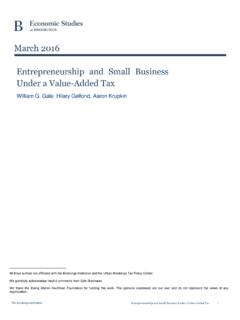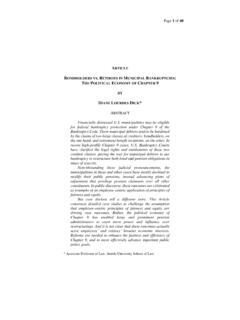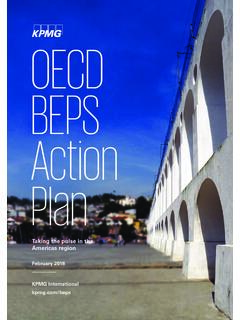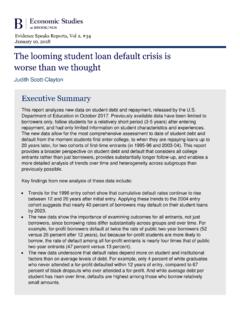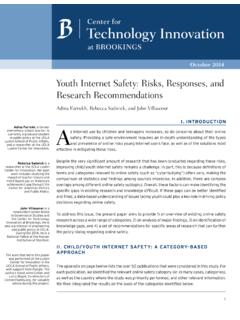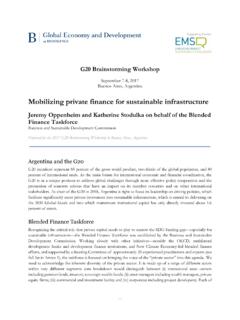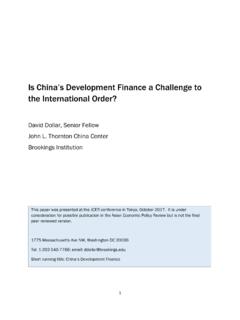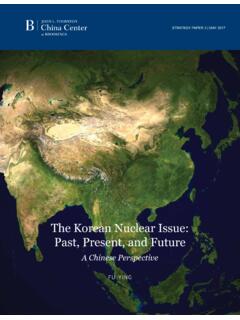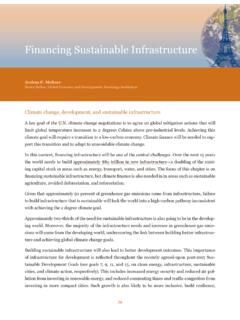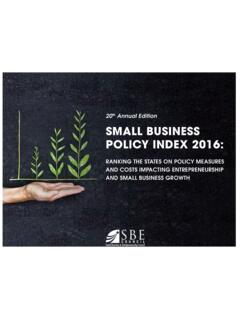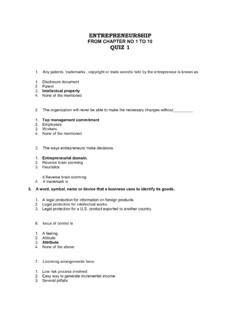Transcription of Women, Entrepreneurship and the Opportunity to Promote ...
1 The 2013 Brookings Blum roundTaBle Policy BriefsEntErprising solutions: the role of the private sector in Eradicating global poverty31 women , Entrepreneurship and the Opportunity to Promote development and Businesscarmen Niethammer, Odebrecht1 ExEcUTIvE SUmmaRyFemale Entrepreneurship represents a vast untapped source of innovation, job creation and economic growth in the developing world. The barriers to wom-en s Entrepreneurship are various: women face greater obstacles in accessing credit, training, networks and information, as well as legal and policy constraints. The World Economic Forum shows little progress in narrowing the economic gap between women and men.
2 Yet not all is lost! Innovative initiatives to pro-mote women s Entrepreneurship driven by both the private and public sectors are on the rise. This brief provides an overview of the global landscape of women s Entrepreneurship . It aims to demystify the challenges that women face in accessing finance, and it highlights some of the typical challenges regarding ca-pacity-building programs targeted at women entrepre-neurs. Above all, this brief focuses on potential solu-tions and enablers by drawing on practical experiences from the public and private sectors in both emerging and developed markets. It concludes that innovative partnerships, particularly when private and public sec-tor entities are involved, are beginning to make a dent, with the potential for large-scale impact.
3 Those who embrace women s Entrepreneurship as an Opportunity are likely to reap the rewards in new market opportu-nities and higher development impact. ThE LaNdScaPE Of women S Entrepreneurship aROUNd ThE WORLdWomen s Entrepreneurship matters for business and development. women -owned businesses already contribute significantly to the world economy, and their number has grown over time. These firms represent a significant share of employment gener-ation and economic growth potential. This contrib-utes significantly to development beyond enterprise growth and turnover numbers. women are better at managing the budget and better at making key financial decisions that impact the family such as a child s education, noted Mastercard s group head for Asia, Pacific and the Middle East and North A recent survey in Asia found that when it comes to home finances, women generally play a leading role.
4 women s leadership in South Korea, Indonesia and Vietnam was especially apparent when mak-ing decisions about their children s education, and women also were the main decisionmaker when it came to key household purchases. It is estimated that women -owned small and medium-sized en-terprises (SMEs) represent 31 to 38 percent (8 to 10 million) of formal SMEs in emerging The number of female-owned enterprises is grow-ing at a faster pace than that of male counter-parts with no evidence that women -owned en-terprises fail at a faster rate. New, internationally comparable data on female Entrepreneurship from countries belonging to the Organization for Eco-nomic Cooperation and Development show that the birth rates of female-owned enterprises are high-er than those of male-owned ones (see figure 1).
5 4 The ratio of Opportunity to necessity entrepreneur-ship is typically higher in high-income countries than in low-/middle-income country groups, the effect being significantly greater for women entrepreneurs, The 2013 Brookings Blum roundTaBle Policy BriefsEntErprising solutions: the role of the private sector in Eradicating global poverty32according to the Global Entrepreneurship In other words, the poorer the country, the more likely that women s Entrepreneurship is driven by ne-cessity. Regardless of gender, entrepreneurial activity is typically higher in low- and middle-income coun-tries than in high-income countries. women increasingly outnumber men in universities and graduate schools in emerging markets (including the BRIC countries Brazil, Russia, India and China), representing a growing talent pool and a huge oppor-tunity for both business and development.
6 In countries where the public sector s role for female employment is diminishing and where private sector careers are not easily being pursued, women look to establish and grow businesses themselves. From a public sec-tor perspective, an unutilized educated workforce is costly and not effective. In Brazil, Russia and the United Arab Emirates, for example, women remain a disproportionately untapped source of promotion of women s Entrepreneurship can play a particularly important role in conflict-affected countries. Although destruction affects all, conflict often leaves women to carry the double burden of economic and family responsibilities. women who can no longer rely on steady earnings from male household mem-bers during times of hardship must often make ends meet by engaging in informal micro-income-gener-ating activities.
7 Giving women a stake in the national reconstruction process by investing in their econom-ic participation, including through Entrepreneurship , is crucial for effective and sustainable development of the already-fragile economies of conflict-affected enterprises are well-positioned to en-hance national prosperity and to contribute to econom-ic growth and development. Many are growth-orient-ed and are increasingly operating firms across all industry sectors and engaging in global trade. It is against this backdrop that both the private and public sectors are innovating to identify opportunities to Promote women s Entrepreneurship in order to har-ness this untapped potential.
8 3530252015105035302520151050%%austriafin landItalyNetherlandsNew ZealandSlovak RepublicSpainSwedenaustriafinlandItalyNe therlandsNew ZealandSlovak RepublicSpainSwedenWomenmena) Births refer to the creation of new enterprises with employees or to transitions of existing enterprises from 0 to 1+ employee(s). Deaths refer to the dissolution of enterprises or to transitions to no : OECD Secretariat estimates based on statistics produced by National Statistical Institutues. Death rates for Italy, the Netherlands, Sweden and the Slovak Republic refer to and death ratesa of women and men sole-proprietor enterprises, 2009 Birth ratesdeath ratesFIgure 1. The bIr Th raTes oF Female-owned enTerprIses are hIgher Than ThaT oF male-owned onesSource: Organization for Economic Cooperation and Development, Closing the Gender Gap: Act Now (Paris: OECD Publishing, 2012).
9 The 2013 Brookings Blum roundTaBle Policy BriefsEntErprising solutions: the role of the private sector in Eradicating global poverty33 UNRavELING ThE mySTERy Of women S LImITEd accESS TO fINaNcE The business rationale for investing in women -run en-terprises is gaining support on compelling economic grounds. Gender equality is a core development ob-jective in its own right and, also smart economics, highlights the World Development Report 2012: Gen-der Equality and Despite this growing awareness, and the fact that women -owned businesses represent a strong potential source of future economic growth and job creation, there are notable differences between women - and men-owned businesses: Wom-en-owned businesses are concentrated in industry sectors where firms are typically smaller ( , retail and services, compared with manufacturing).
10 women entrepreneurs are more likely to cite access to finance as the first or second barrier to developing their businesses. There are significant gender differences in the access to and use of credit particularly formal credit. Businesses managed by women are less like-ly to receive a loan than firms managed by men, al-though the differences narrow with firm size and are smaller among formal businesses. It is estimated that women -owned businesses have an annual financing gap of $290 billion to $360 billion in unmet financ-ing needs, according to a report commissioned by the Group of have a lower formal bank account penetration than men in every region, particularly in developing countries, confirms the new Global Financial Inclu-sion Index (Global FINDEX), which measures how people in 148 countries save, borrow, make payments and manage risk.
